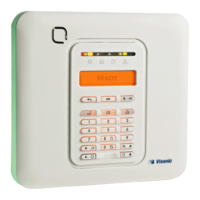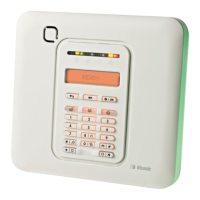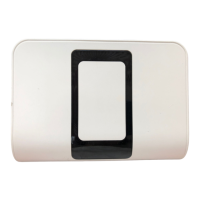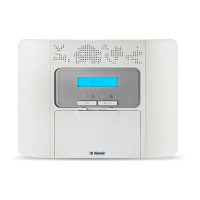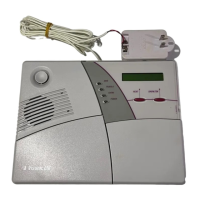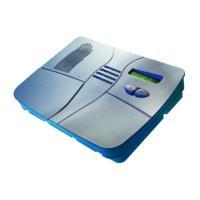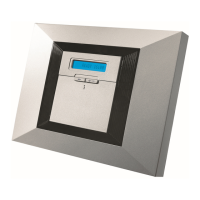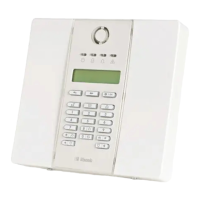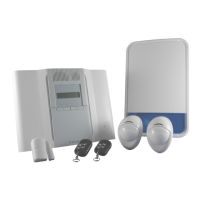Do you have a question about the Visonic POWERMASTER-10 - INSTALLER GUIDE and is the answer not in the manual?
Details system functionalities like zone count, zone types, user codes, display, and arming modes.
Covers frequency band, antenna type, encryption, and protocol for wireless communication.
Details electrical requirements including AC/AC adapter, current drain, battery voltage, and backup battery.
Outlines communication methods like built-in modem, data transfer, report destinations, and reporting formats.
Lists physical attributes such as operating temperature range, humidity, size, weight, and color.
Explains connecting power to the unit, including backup battery and AC power.
Emphasizes planning the system and using appendices for detector/transmitter registration.
Details physically mounting the control panel unit using a screwdriver and wall anchors.
Covers installation of optional modules like GSM and PowerLink Broadband.
Describes final steps for closing the control panel after installation.
Recommends programming the unit on a workbench before final installation.
Provides instructions for accessing the installer menu on the control panel.
Explains menu navigation using control panel pushbuttons.
Details code levels (Installer, Master Installer, User) and their permissions.
Manages system zones and devices, including adding, deleting, and modifying.
Configures siren behavior, bell time, internal siren, and strobe light activation.
Sets up event reporting to monitoring stations and users.
Configures security features like cross zoning, swinger stop, and jamming detection.
Configures arming/disarming modes, exit delays, and entry delays.
Customizes UI elements like trouble beeps, back light, and screen saver.
Allows defining up to 5 custom locations for devices.
Configures output parameters, including PGM output and lighting device behavior.
Grants remote access and sets passwords for data download/upload.
Tests functionality and signal strength of all enrolled system devices.
Provides solutions for common system faults.
Details steps for removing the control panel from its mounting surface.
Explains how to replace the backup battery pack for the control panel.
Explains the fuse has automatic reset and requires no replacement.
Guides on replacing or relocating detectors, recommending a diagnostic test.
Details how to reset the PowerMaster-10 parameters to factory default settings.
Explains how to view the system serial number, unit version, and panel ID.
Provides instructions on accessing and scrolling through the system's event log.
Details the process for clearing the event log and exiting the log viewing mode.
Template for planning detector placement, zone types, and chime assignments.
List for recording keyfob transmitter data and AUX button assignments.
List for recording emergency transmitter details (type, zone, holder).
List for recording non-alarm transmitter details and assignments.
Lists Contact ID event codes and their definitions for reporting.
Lists SIA event codes and their definitions for reporting.
Provides a note on 4/2 event codes for reporting to monitoring stations.
Explains the data format used in the Scancom reporting protocol.
Details system functionalities like zone count, zone types, user codes, display, and arming modes.
Covers frequency band, antenna type, encryption, and protocol for wireless communication.
Details electrical requirements including AC/AC adapter, current drain, battery voltage, and backup battery.
Outlines communication methods like built-in modem, data transfer, report destinations, and reporting formats.
Lists physical attributes such as operating temperature range, humidity, size, weight, and color.
Explains connecting power to the unit, including backup battery and AC power.
Emphasizes planning the system and using appendices for detector/transmitter registration.
Details physically mounting the control panel unit using a screwdriver and wall anchors.
Covers installation of optional modules like GSM and PowerLink Broadband.
Describes final steps for closing the control panel after installation.
Recommends programming the unit on a workbench before final installation.
Provides instructions for accessing the installer menu on the control panel.
Explains menu navigation using control panel pushbuttons.
Details code levels (Installer, Master Installer, User) and their permissions.
Manages system zones and devices, including adding, deleting, and modifying.
Configures siren behavior, bell time, internal siren, and strobe light activation.
Sets up event reporting to monitoring stations and users.
Configures security features like cross zoning, swinger stop, and jamming detection.
Configures arming/disarming modes, exit delays, and entry delays.
Customizes UI elements like trouble beeps, back light, and screen saver.
Allows defining up to 5 custom locations for devices.
Configures output parameters, including PGM output and lighting device behavior.
Grants remote access and sets passwords for data download/upload.
Tests functionality and signal strength of all enrolled system devices.
Provides solutions for common system faults.
Details steps for removing the control panel from its mounting surface.
Explains how to replace the backup battery pack for the control panel.
Explains the fuse has automatic reset and requires no replacement.
Guides on replacing or relocating detectors, recommending a diagnostic test.
Details how to reset the PowerMaster-10 parameters to factory default settings.
Explains how to view the system serial number, unit version, and panel ID.
Provides instructions on accessing and scrolling through the system's event log.
Details the process for clearing the event log and exiting the log viewing mode.
Template for planning detector placement, zone types, and chime assignments.
List for recording keyfob transmitter data and AUX button assignments.
List for recording emergency transmitter details (type, zone, holder).
List for recording non-alarm transmitter details and assignments.
Lists Contact ID event codes and their definitions for reporting.
Lists SIA event codes and their definitions for reporting.
Provides a note on 4/2 event codes for reporting to monitoring stations.
Explains the data format used in the Scancom reporting protocol.
| Category | Security System |
|---|---|
| Model | POWERMASTER-10 |
| Wireless Protocol | PowerG |
| Backup Battery | Yes |
| User Codes | Up to 48 user codes |
| Type | Wireless Alarm System |
| Partitions | 3 |
| Communication | GSM |
| Wireless Frequency | 868 MHz |
| Keypads | Up to 8 keypads |
| Event Log | 1000 events |
| Power Supply | External power supply |
| Backup Battery Voltage | 7.2V |
| Operating Temperature | -10°C to +50°C |
| Humidity | 85% non-condensing |
| Zones | Up to 30 wireless zones |

